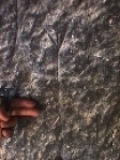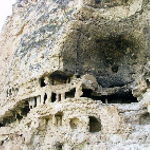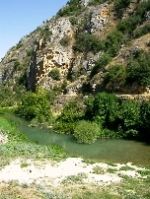Archeology of Settlement in Phrygia
A Project of Department V: Theology and Archaeology
Discovery and archeological exploration of Pepouza and Tymion, the two most important cities of Montanism in Phrygia
Prof. Dr. Peter Lampe

Graffito in Pepouza
From the second to the sixth centuries C.E., these towns were the main centers of a charismatic-ecstatic Christian movement known as the Montanist church, which spread from Phrygia throughout the entire Roman Empire. Pepouza was the Montanist's primary locality as well as their most important pilgrimage center. Their patriarch resided there. Unusually for Christian movements of the time, women could rise to be priests and bishops within the Montanist church. Eminent eschatological events, including the descent of the "heavenly Jerusalem," were expected to take place in Pepouza and Tymion. Designed as an interdisciplinary settlement-archeological regional survey (modernized transect method), the project explores an entire cultural landscape in the south of UÅŸak (Turkey) with all of its cultural-historical time periods from the Neolithic to the Ottoman periods.
An Interdisciplinary Project
Designed as an interdisciplinary settlement-archeological regional survey (modernized transect method), the project explores an entire cultural landscape in the south of UÅŸak (Turkey) with all of its cultural-historical time periods from the Neolithic to the Ottoman periods.
Not only will the ancient settlement areas be examined as in traditional surveys, but also their extended environment: the ancient paths of transportation and irrigation, the ancient methods of land use, and the relationship between the human settlements and natural environment. Therefore, in addition to archeology and geology, also paleobotany and phytogeography play a role in the investigations. In this way, the survey attempts to increase the understanding of the living conditions of the ancient population in the countryside in Phrygia, an area largely unexplored by research so far. The survey thus unveils glimpses of the social, economic and religious histories of the area.

Felsenkloster (Banaz)
The primary questions that arise in regard to religious history are: How did the polytheistic religiosity of the people of the countryside develop into monotheism, first with the Judeo-Christian and later with the Islamic faith? Why did the radically monotheistic Montanism spread so rapidly, particularly in the hinterland of the Roman Empire? While early Christianity in the urban setting is relatively well researched, so far this is not the case for the rural areas. Especially in this region where Christian Montanism was dominant, the survey can productively correlate archeological evidence with that from the ancient literary sources.
Reconstructions and Investigations
Since there are no satisfactory maps for the part of Phrygia south of Uşak (Turkey) under investigation, the survey team also performs considerable cartographic work. In addition, virtual three-dimensional reconstructions of characteristic settlement structures are being made.
As is the practice in settlement archeology, within a measured grid the small surface finds (such as ceramics, glass, metal objects, etc.) are gathered and identified. For the most part, the ceramics of this region have not been well researched. Working together with Italian specialists, progress in the identification of these ceramics is being achieved. Of course, also epigraphics play an important role in the research.
The existing settlement structures above the ground are documented archeologically. Geophysical examinations (using geomagnetic and ground radar) provide valuable information about the underground structures. Without disturbing the ground, in many places geophysics makes later excavations unnecessary. Probe digs are planned only where the geophysical examinations are insufficient.

Der Banaz-Canyon
The project is planned in different stages:
- In the territory of Pepouza, Tymion and the other settlements discovered so far (such as Simoe), intensive surveys that cover all of the surfaces are being conducted. Every period of civilization is being examined.
- In a larger geographical area of 70 km2, all historical periods are also investigated. However, with the much larger area, not all surfaces can be covered with the same intensity. As many sites as possible are registered. The areas to be investigated are determined with the aid of aerial and satellite pictures and of the local farmers' knowledge.

